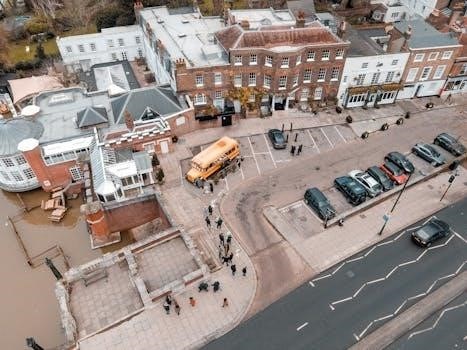Street parking regulations in Washington residential areas aim to ensure fair access, public safety, and efficient traffic flow. These rules balance resident needs with public access and emergency vehicle movement, promoting community well-being and order.
The primary purpose of street parking regulations in Washington’s residential zones is to manage public space effectively. These rules aim to mitigate hazards, maintain clear traffic flow, and ensure accessibility for emergency vehicles. Regulations also strive to balance the parking needs of residents with the availability of space, preventing long-term vehicle storage and promoting equitable usage. Additionally, these rules enhance neighborhood aesthetics and safety by preventing obstructions and abandoned vehicles, contributing to an improved quality of life for residents.
Overview of Street Parking Rules in Washington Residential Areas
Purpose of Street Parking Regulations
Applicability to Residential Zones
Street parking regulations in Washington State generally apply to all publicly accessible streets within designated residential zones. However, the specific rules and enforcement may vary based on local ordinances and municipal codes. Some regulations might be universally enforced across the state, while others are specific to individual cities or counties. These regulations aim to manage parking effectively in residential areas, taking into account local needs and conditions. Residents should consult their local government websites for precise details.
RCW (Revised Code of Washington) References
Washington State laws, particularly the Revised Code of Washington (RCW), establish the framework for parking regulations. These state laws grant local jurisdictions the authority to enact and enforce specific parking rules.
RCW (Revised Code of Washington) References
The Revised Code of Washington (RCW) contains essential statutes regarding vehicle parking. Specifically, the RCW addresses parking restrictions near intersections, fire hydrants, and driveways. State law, codified within the RCW, grants cities and counties the power to regulate parking within their jurisdictions. This includes setting time limits, establishing permit zones, and enforcing parking violations. The RCW ensures a baseline of parking regulations across Washington, while allowing for local adaptation.

Key Washington State Laws and Regulations
State vs. Local Control
Washington operates under a system where both the state and local governments have authority over parking regulations. The state sets a general framework through the RCW, while cities and counties implement specific rules tailored to their needs. Local ordinances can address unique parking challenges, such as high-density areas or specific neighborhood concerns. This balance allows for both statewide consistency and local flexibility in managing parking within residential zones, ensuring adaptability to diverse community needs.
Parking restrictions in Washington detail specific distances vehicles must maintain from intersections, driveways, fire hydrants, and crosswalks. These regulations ensure visibility, access for emergency services, and pedestrian safety in residential areas.
Distance from Intersections, Driveways, Fire Hydrants, and Crosswalks
Washington State law and local ordinances establish minimum distances for parking near intersections, driveways, fire hydrants, and marked or unmarked crosswalks. Parking is generally prohibited within 20 feet of a crosswalk, 15 feet of a fire hydrant, and five feet of a driveway. Specific distances near intersections are typically around 30 feet from stop signs, yield signs, or traffic signals. These restrictions aim to maintain clear visibility for drivers and pedestrians, ensure access for emergency vehicles, and prevent obstruction of roadways, thus promoting public safety in residential areas by reducing accident risks and facilitating emergency response.
Parking Near Stop Signs and Traffic Signals
Parking near stop signs and traffic signals in Washington State residential areas is strictly regulated to maintain visibility and ensure traffic flow. Typically, vehicles are prohibited from parking within 30 feet of any stop sign, yield sign, or traffic signal. These restrictions prevent parked cars from obstructing the view of drivers approaching intersections, reducing the risk of accidents. Clear visibility of these traffic control devices is essential for safe navigation and adherence to traffic laws, particularly in residential neighborhoods where pedestrian and bicycle traffic may also be present, thereby enhancing overall road safety.
Specific Parking Restrictions
Restrictions on Parking Recreational Vehicles
Washington State imposes restrictions on parking recreational vehicles (RVs) in residential areas to manage street space and maintain neighborhood aesthetics. Municipal codes often limit the duration an RV can park on a city street, sometimes to a maximum of 24 hours. These regulations prevent long-term RV storage on public streets, ensuring fair use of parking spaces. Additionally, RVs must comply with all other parking rules, such as not obstructing traffic or sidewalks. Local ordinances aim to balance the needs of RV owners with the community’s interest in preserving residential quality and access, preventing neighborhood clutter.
White curb markings in Washington indicate areas for short stops only. Parking is restricted to quick passenger loading/unloading. Extended parking is prohibited to maintain traffic flow and accessibility.
White Curb Restrictions
White curb markings in Washington State designate zones for temporary stops, typically for passenger loading or unloading. These areas are intended for brief pauses, and extended parking is usually not permitted. Vehicles must not remain stationary for longer than necessary to complete the designated activity. Drivers should always check local signage for specific time limits and restrictions. Violations may result in fines or towing. Observing these regulations helps maintain traffic flow and ensures accessibility for all users. Always prioritize awareness of local guidelines when encountering white curbs.

Curb Markings and Their Meanings
Yellow or Red Curb Restrictions
Yellow or red curb markings in Washington State indicate areas where parking is strictly prohibited. Yellow curbs often denote loading zones for commercial vehicles, while red curbs typically signify fire lanes or areas near fire hydrants. Parking in these zones is illegal and poses safety risks, obstructing emergency services and impeding traffic flow. Violators face fines and potential vehicle towing. Always observe curb color and posted signage to ensure compliance with local regulations. Understanding these restrictions is crucial for responsible parking practices and community safety.
Residential parking permits in Washington offer residents priority parking on their streets. Availability and eligibility vary by city, typically requiring proof of residency and vehicle registration. Permits aim to reduce parking congestion.
Availability and Eligibility
In many Washington residential areas, parking permits are available to residents who meet specific criteria. Eligibility often hinges on proving residency within the designated permit zone, typically requiring documents like a lease agreement or utility bill. Vehicle registration in Washington State at the same address is another common requirement. Some cities limit the number of permits per household to manage parking demand effectively. Availability may also be restricted in areas with limited parking spaces or high traffic volume, prioritizing residents who lack off-street parking options.

Parking Permits in Residential Areas
Restrictions and Limitations
Residential parking permits in Washington State come with several restrictions. The permits typically apply only to specific zones and do not guarantee a parking spot. They often exempt vehicles from time limits but not from other parking regulations like those concerning fire hydrants or intersections. Guest passes are sometimes offered but are also limited in number and duration. Permits are usually non-transferable and must be visibly displayed. Misuse can result in fines or revocation of the permit. Some jurisdictions may have blackout periods during special events.
In Washington, parking in front of houses on public streets is generally legal, subject to local ordinances. Time limits may apply, and vehicles must not obstruct driveways or violate other parking regulations.
Legality and Time Limits
Generally, in Washington, public streets are for everyone, so you cannot claim ownership of the space in front of your house. Parking is typically legal, but subject to city regulations, including time limits to ensure fair access. Check local ordinances and posted signs for specific rules. Parking is not allowed if it obstructs driveways, fire hydrants, or crosswalks. Some cities may offer residential parking permits. Always ensure your vehicle doesn’t violate any posted restrictions to avoid fines.

Parking in Front of Houses
Homeowner Rights vs. Public Access
While homeowners don’t own the street parking in front of their houses in Washington, they do have certain expectations. They can expect reasonable access to their property. However, the curb is public right-of-way, meaning anyone can park there subject to local rules. Homeowners cannot block the space or reserve it for themselves. Disputes often arise when long-term parking by non-residents impacts homeowners. Understanding local ordinances and communicating respectfully with neighbors is key.
Parking requirements significantly impact housing affordability. Mandated parking spaces increase construction costs, raising rental costs and home prices. Reducing parking minimums and exploring alternative strategies can mitigate these effects, fostering more affordable housing options.
Affordability Considerations
Parking mandates tied to housing developments in Washington state can significantly impact affordability. Requiring off-street parking increases construction costs, which are then passed on to renters and homebuyers. Studies show that bundled parking, where parking costs are included in the rent or purchase price, inflates housing expenses, especially affecting low-income residents. Relaxing or eliminating parking minimums can reduce housing costs, promoting more accessible and affordable living options. Local governments are exploring strategies to regulate parking, pricing, and management to address affordability challenges.
Impact of Parking Requirements on Housing
Parking Minimums and Maximums
Washington State faces the potential for severely limited city control over parking mandates. This can affect housing density and affordability. Many jurisdictions require multiple off-street parking spaces per detached home, despite a significant portion of households owning few or no cars. Parking minimums increase development costs, impacting project feasibility. Conversely, some areas explore parking maximums to encourage alternative transportation. The state considers legislation to modernize parking regulations, potentially influencing minimums and maximums to balance housing needs and transportation goals.
Metered parking violations in Washington involve penalties for not paying the meter fee during posted time limits. Enforcement ensures compliance and revenue generation for parking services, with fines varying based on location and violation severity.
Metered Parking Violations
Metered parking violations occur when drivers fail to pay the required fee at parking meters during the designated time limits. These infractions are actively enforced to ensure compliance with parking regulations and to maintain revenue streams for local governments. Penalties for metered parking violations in Washington can include fines, which vary depending on the location and the specific violation. Repeat offenders may face increased fines or other consequences. Mobile payment options are often available, but failure to utilize them or exceeding the allotted time results in a violation. Enforcement officers monitor metered zones.
Enforcement and Penalties
General Parking Infractions
General parking infractions in Washington State encompass a broad range of violations beyond metered parking. These include parking in prohibited zones such as intersections, sidewalks, and in front of driveways. Violations also occur when vehicles are parked too close to fire hydrants, crosswalks, stop signs, or traffic signals. Blocking street planting strips or parking against traffic flow also constitute infractions. Penalties for these violations typically involve fines, which may escalate for repeat offenses. Enforcement is carried out by parking officers who patrol residential and commercial areas. Vehicles may be towed if they pose a hazard.
Local government websites and documents are valuable resources for detailed information on street parking rules in Washington residential areas. These sources often include specific municipal codes, regulations, and contact information.
Local Government Websites and Documents
Local government websites and documents are essential resources for understanding specific street parking rules within Washington’s residential areas. These websites, like the MRSC, often provide access to municipal codes, zoning regulations, and parking ordinances directly applicable to each city or county. You can find information on permit requirements, restrictions, and enforcement policies. Reviewing these official sources ensures compliance with local laws, helping residents and visitors avoid parking violations and related penalties, such as those for metered parking.
Resources for Further Information
Washington State Department of Transportation
The Washington State Department of Transportation (WSDOT) offers valuable information, though its focus is broader than just residential parking. WSDOT provides insights into state laws affecting vehicle operation and parking regulations, potentially including sections relevant to residential areas. While local ordinances primarily govern specific neighborhood parking rules, WSDOT resources can clarify overarching state statutes concerning parking enforcement, vehicle restrictions, and general traffic laws applicable statewide. This helps ensure a comprehensive understanding of both state and local parking guidelines.

